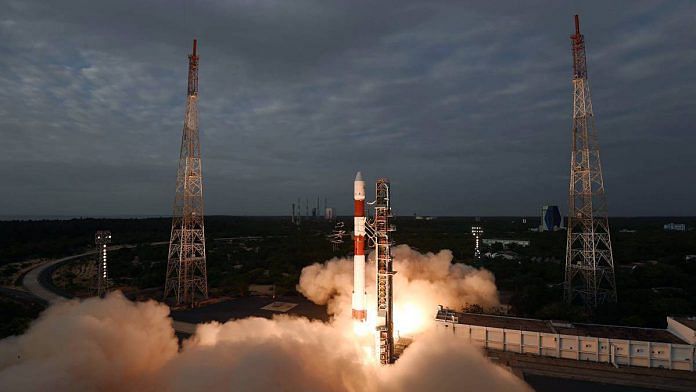On Tuesday, PM Narendra Modi announced three new space projects with a combined cost of Rs 1,800 crore. The projects were announced at Kerala’s Vikram Sarabhai Space Centre, where the names of India’s first four astronaut candidates were also declared. One of the projects announced is a new facility in Andhra Pradesh’s Sriharikota, at one of the launchpads, called the PSLV Integration Facility. ThePrint explains what the complex will do, in the first of a three-part series.
Bengaluru: In an effort to increase the number of PSLV rocket launches and launches of other small vehicles, the Indian Space Research Organisation (ISRO) has built and formally launched a PSLV Integration Facility (PIF) in Andhra Pradesh’s Sriharikota.
The new facility, inaugurated by Prime Minister Narendra Modi Tuesday, will enable quicker assembly and integration of the PSLV (Polar Satellite Launch Vehicle) and smaller rockets at the launchpad.
The complex is an augmentation of the First Launch Pad (FLP) at the Satish Dhawan Space Centre in Sriharikota.
The move is expected to increase PSLV launches annually, from about six to over double the number, at 12 or 15. Launches of customer satellites through India’s trustiest rocket PSLV are ISRO’s primary source of revenue.
The PIF is also expected to help launch smaller rockets and private launch vehicles in the future.
Also Read: Start-ups welcome govt move to liberalise FDI rules for space sector — ‘long-pending reform’
Rocket integration
A giant vehicle such as a rocket, having multiple stages, is constructed in parts. These parts and stages of the rockets are put together at a facility, in a process known as integration. This happens close to the launch location, at the launchpad.
In ISRO’s case, launch vehicles are assembled at the Vehicle Assembly and Launching Facility (VALF) near the Sriharikota launchpads.
In the PSLV launch complex, the 12-metre-high rocket is integrated vertically and roped into an umbilical tower within a structure called the vehicle assembly building, which is part of the VALF. The mobile tower then rolls out on rails for 100 metres, to the launchpad.
The PIF is an augmentation of the first launchpad or FLP. Its objective is to enable quicker assembly and integration of PSLVs closer to the launchpad.
While ISRO flies about six PSLV missions a year, a fully realised PIF will enable the space agency to launch up to 15 PSLVs a year. This is expected to provide a major commercial boost to the ISRO, as the PSLV is one of the agency’s trustiest rockets.
India has conducted a total of 60 PSLV launches since the 1990s, of which only two failed and one experienced a partial failure. The launch vehicle has sent to space India’s first mission to the moon, to Mars, and to study the sun.
Boost to private players
The PIF is capable of providing integration, checkout, and launch support to other launch vehicles that are smaller than the PSLV. These include the SSLV (Small Satellite Launch Vehicle), ISRO’s new rocket for much smaller satellites.
Mainly, the PIF will play a key role in facilitating private rocket launches.
Today, there are multiple private companies and startups such as Skyroot Aerospace and Agnikul that plan to develop their own rockets and launch vehicles. Some even build smaller sounding rockets that do not fully reach orbit and are used for atmospheric studies and student projects.
With its integration, services, rail system and other support, the PIF will enable quicker and steady launches of these too, boosting the private space ecosystem in India.
Other facilities
The Satish Dhawan Space Centre (SDSC) was formerly called the Sriharikota Range or SHAR. It has two launchpads, the FLP and second launch pad (SLP).
There are also facilities for propellant production, rocket motors, testing of motors and their subsystems, testing facilities for shock, vibration, acceleration, thermal and humidity tests, and thrust. The entire launch complex provides end-to-end support for vehicle assembly, testing, and launch.
Many sections of SDSC-SHAR are also being modified and augmented with additional facilities, as ISRO’s expertise with various classes of rockets grows.
For GSLV (Geosynchronous Satellite Launch Vehicle) MkIII support, a new plant was set up to process solid propellant. More test complexes, a solid stage assembly building, hardware and fuel storage facilities, satellite assembly facilities, instrumentation systems, and more have been set up in recent years. It even has a weather radar for launches, which doubles up as Chennai’s doppler radar for weather.
While the PIF is being augmented to the FLP, the SLP will be augmented with additional facilities and structures for the Gaganyaan mission and crewed flights.
With the completion of the PIF, ISRO is aiming for a drastic increase in frequency of PSLV and smaller launch vehicle missions.
(Edited by Nida Fatima Siddiqui)
Also Read: Making of 4 astronauts for Gaganyaan — rigorous training, medical & fitness tests, survival tasks



